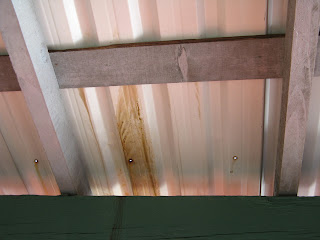 If you use a fireplace or woodstove, you know that creosote is the dangerous buildup of smoke and vapor residue in the chimney. If you burn a hot, fast fire, combustion is more complete and creosote buildup is less likely. It's when you close down the flue to let the fire burn low and slow that creosote builds up quickly.
If you use a fireplace or woodstove, you know that creosote is the dangerous buildup of smoke and vapor residue in the chimney. If you burn a hot, fast fire, combustion is more complete and creosote buildup is less likely. It's when you close down the flue to let the fire burn low and slow that creosote builds up quickly.When the temperature within the chimney gets below 121 degrees Celsius (250 F), the gases liquify to form creosote. My Imperial Magnetic Stove Thermometer helps me monitor and control this.
 We notice that liquid creosote production is more pronounced when the temperature drops below freezing. This super cools the outside portion of the chimney.
We notice that liquid creosote production is more pronounced when the temperature drops below freezing. This super cools the outside portion of the chimney.The morning after a particularly clear and cold night, we went outside to discover liquid creosote crud all over our picnic table.
 It dripped down through the vertical chimney pipe, out the clean-out hatch at the bottom, and onto the metal porch roof. Because our roofing was recycled, it dripped through empty screw holes and right down onto the picnic table underneath. Liquid creosote is greasy, dark, thick, and has a strong burned odour.
It dripped down through the vertical chimney pipe, out the clean-out hatch at the bottom, and onto the metal porch roof. Because our roofing was recycled, it dripped through empty screw holes and right down onto the picnic table underneath. Liquid creosote is greasy, dark, thick, and has a strong burned odour. After a hot fire the next day, the liquid creosote dried up. But that is also a dangerous condition. Every other month Wayne goes up on the roof to thoroughly clean any creosote out of the chimney pipe. Once a year we remove the inside portion to do the same.
After a hot fire the next day, the liquid creosote dried up. But that is also a dangerous condition. Every other month Wayne goes up on the roof to thoroughly clean any creosote out of the chimney pipe. Once a year we remove the inside portion to do the same.Do you use a wood stove or active fire place? How do you take care of creosote? -- Margy
Eeww, that looks awful on your picnic table, Margy.
ReplyDeleteMaybe I'm glad we don't have a fireplace. My husband is definitely not into chimney checking and cleaning.
K
It's not as hard as it sounds, but in our particular case Wayne has to go up on the porch roof to reach the pipe. My fear of heights keeps me on the ground with ladder holding duty. But I do help with the inside chore. You can also hire chimney sweeps to do the job, so don't let that keep you away from installing a wood stove in the future. They are great, and fun to sit and watch. - Margy
ReplyDeleteThanks for this important information! We've only regularly used our wood stove for the past year, but I do believe we need to be paying closer attention to this creosote issue. We have the same thermometer you have, but after using it throughout the night to keep the cabin somewhat warm, I am sure the temp gets below 250F...thanks again!
ReplyDeleteI never knew this about fireplace chimneys. Good to know.
ReplyDeleteOur wood heating stove is banked back regularly, so we have a lot of interaction with creosote. My husband doesn't have to go on the roof to clean our chimney out, he does it from upstairs. That job is down monthly here. Glad its not my job!
ReplyDeleteI wanted to tell you I saw your video on uTube and loved it. It was great! You did an awesome job!!!!
Kathleen - Me too. I'm glad Wayne goes up on the porch roof. I'm a bit afraid of heights. Thanks for watching the video. We have fun sharing our lifestyle. - Margy
ReplyDelete